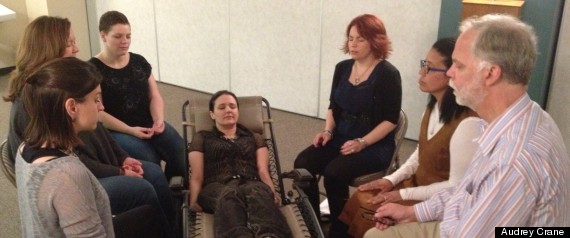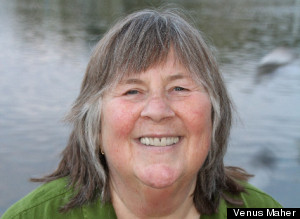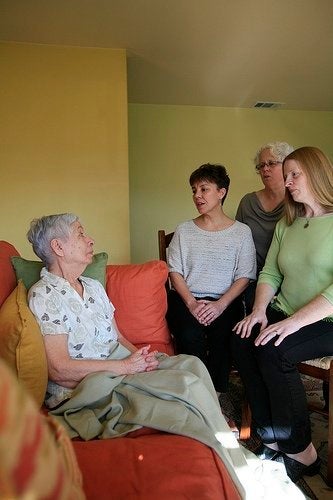WASHINGTON -- Always face the person in the chair. Sense their breath, the rising and falling of the lungs, the blood's flush on the cheeks. Watch the loosening and tightening of the muscles, the movement of the eyelids, how the hair on their arms straightens up. Don't stand out. Speak softly. Blend in with the voices.
This was the advice of Ellen Synakowski to members of the Washington, D.C., Threshold Choir, only a few months into its existence. Their job: to use song to comfort the dying through the end of life.
As if repeating a mantra, they sang in unison as they rehearsed: "It's alright, you can go/ Your memories are safe with us/ It's alright, you can go/ Your memories are safe with us."
"Words are good for many things, but they don’t seem sufficient when it comes to death. The feelings are just too deeply intense and words are too inadequate," said Synakowski, a 55-year-old former academic journal editor who has always had a hobby of singing, whether it's to the car radio or in a community chorus. "But music … music can reach those places where words alone can’t go."
Death used to happen solely at home or in a hospital, with company limited to family, close friends and clergy. Solemn music would be reserved, perhaps, for the funeral. But as the options for the end of life have grown to include hospice, palliative care and other avenues that recognize not only physical but also emotional and spiritual well-being, Synakowski and like-minded volunteers are offering another service to the dying: soothing through a cappella song.
Each week, Synakowski and between five and 10 people gather around an imaginary bed to practice original songs written for the dying. The D.C. circle formed in January, and is one of the newest in a little-known, mainly U.S.-based network that began in Northern California 13 years ago and now includes dozens of groups across the country.
In the years before launching the choir, Synakowski was a theater critic, a parenting newspaper staffer and an editor at a physics journal. Now an aspiring creative nonfiction writer, she spends her days memorizing songs, calling hospices and hospitals to gauge their interest in bedside singers, and placing ads seeking members in coffee shops, churches and newspapers. But it's not easy to find volunteers and she's just started to look for friendly care facilities that may house those who are dying and willing to listen.
"Do not initiate touch. If someone reaches out to you, you can respond," she told the men and women gathered to practice in April in a massage school classroom in a nondescript, concrete office building that donated its space. It was a Wednesday night, and the singers, most in their 20s and 30s, had rushed in from their day jobs. They included a legal secretary, a massage therapist and an acupuncturist. "If someone asks you for water, or to adjust them in their wheelchair or bed, we can't," Synakowski said. That's up to the nurse. They are singers, and singers only.
As if it were a worship service, she opened the meeting with a testimony, reading a letter from a woman who recently had another choir in California sing to her ailing mother who is in her late 80s. The students had never performed for the ill or dying, and they needed encouragement and inspiration.
"When you came to our church and sang, I had more energy than I have had in many months. When you and the choir sang to my mom, I felt your singing was able to hold a space open that we all fear. That 'space' could be death or just the struggle of sickness, and when it's held open like that, we are less alone in it ... When you sang, your voices had a kind of wisdom of being in dark places or feared places ... My mom told me the feeling overwhelmed her, while you were all singing to her, of not being afraid to die."
The D.C. choir practices for 90 minutes each week at the Potomac Massage Training Institute, where Synakowski is also a student. Laureen, the acupuncturist, joined after seeing a flyer at Starbucks seeking people who could "communicate kindness" with their voices. Becca, the legal secretary, had taken a class at the massage school, through which she met Synakowski. She brought her friend Leah, who has wanted to work with the dying ever since her brother died of cancer.
It will take six months, possibly up to a year, before the choir can reach its goals: having each member memorize 30 songs, and reaching enough understanding of the dying process and the effect sound can have during it, including receiving hospital and hospice volunteer certification.
For now, they prepare.
***
Synakowski's husband and one or two men come to each rehearsal, though most Threshold Choirs are made up of only women. They're located in nearly every major American city, and meet once or twice a month to practice. Each choir varies in its style and composition, though the majority skew older than 50 on average. They visit by request only to hospitals, hospices and private homes. The service is free, and because of limited resources, the groups usually don't advertise unless they are just getting started. Oftentimes, it's a chaplain, social worker or doctor who asks for them.
Two to three singers will go to a bedside, and they pick songs based upon what a patient or the patient's family wants. The tunes can be slow or upbeat, and emotional or lighthearted, like "Take Me Out to the Ballgame," though most are original. At first, choirs sing two or three songs to gauge a person's response. Sometimes, the recipient will move a finger, mouth a "thank you" or will change their breathing and relax their muscles. At the end of life, when human functions began to slow and cease, the signal for "I like this" can be as simple as a blink. Sessions last between 15 to 45 minutes, depending on the patient.
Family members are given song sheets so they can join in or continue after the singers are gone, though choir members themselves prefer memorization. The lyrics aren't religious, and are meant for those who may be spiritual but don't follow a strict dogma. It's rare for a choir member to witness a patient's last breath. Most people prefer to die alone or in the presence of family, say singers who have performed at deathbeds.
So far, Synakowski can sing just 10 pieces from memory. And while she has attended choir workshops in New York and Ohio, she has yet to sing to the dying. Searching fruitlessly for a choir since moving to D.C. nearly four years ago, she became tired of waiting and recently launched her own. Maybe she hadn't sung to the dying before, she thought, but she loved to sing, was taught by the pros and felt at ease with death.
When the D.C. singers gather, Synakowksi doesn't just train them in music, but poses questions about the end of life. What role does song play in transitions? What do they want to hear in their last week alive? The aim is to steer their minds toward thinking about the death that will soon surround them, and to weed out the uncomfortable. She starts by sharing her own experience.
Growing up in Lincoln, Maine, she sang in nursing homes with her Girl Scout troop. She went to her first funeral, for her aunt who died of ovarian cancer, when she was in third grade, and has vivid memories of the open casket and the raw grief in her rather stoic family. She was in her high school's chorus, and was in a gospel choir as an adult until one of her vocal chords started to get chronically swollen about six years ago, making it tiring to sing for extended periods.
When her father died of a septic aneurism back home in 2000, she joined her siblings and mother in touching him, holding his cheeks, his legs and his feet, though she never thought to sing. When her mother was dying eight years later, Synakowski remembers rushing during the two-hour commute from the Bangor airport to her childhood home and spontaneously breaking out into song: "Swing low, sweet chariot/ Comin' for to carry me home." While singing, she got a call that her mother had died. It was one of the first times she realized "the transcending energy of music," she says.
"I feel almost responsible to show up and do this because I understand not being (alive)," she says.
Syankowski first heard about bedside choirs six years ago, when she lived in the San Francisco Bay Area, where the family moved for her husband's job as a physicist. She came across the idea the way most people do: through word-of-mouth. But between work and taking care of two kids, it wasn't until recently that she could manage the time to get involved.
There are 19 choirs in Northern California, the epicenter of the bedside singers' movement. They're each aided in one way or another by Kate Munger, the founder and executive director of Threshold Choir. A 63-year-old resident of Inverness, Calif., 40 miles north of San Francisco, she's a lifelong singer and former elementary school music teacher.
Munger, too, remembers the first time she realized the power of song at death. It was early November in 1990, when her close friend Larry was dying of AIDS.
"I found myself doing chores all morning and was supposed to sit by him in the afternoon, but was terrified when the time came," recalls Munger. "He was comatose but agitated."
She was upset, afraid and confused. So she did what she always did in times of trouble: She sang.
"I sang the same song for two-and-a-half hours. As soon as I started singing, he started to calm," she says. The song was Gail McDermott’s "Hello, Moon:" "There's a moon/ There's a star in the sky/ There's a cloud/ There's a tear in my eye/ There's a light/ There's a night that is long/ There's a friend/ There's a pain that is gone/ Long are we waiting awakening/ Long are we singing this song."
It took until 2000, and many years between of Munger teaching music to kids, for the first choir to begin. Launched in El Cerrito, Calif., its first client was a terminally ill friend in her 50s with Lupus. In small groups, the original 15 members sang to her weekly in the nine months before she died, and she gave them feedback. Soft, blended voices felt better, she explained. Singers learned to read her body language. Even the smallest twitch of a limb could mean she was enjoying or put off by the music. At her death, they sang to her for hours on end.
Today, Munger leads Threshold Choir full-time as a registered nonprofit. It has a small part-time staff, 100 chapters across the U.S., Canada and Australia, and a repertoire of 500 original songs written in a dozen languages. Most are no more than two minutes long, and have been perfected at annual camps that members organize in Northern California. The most recent one in April at a retreat center in Sonoma County drew 140 women. The titles of songs sung during those five days invoke wonder, ease and tenderness: "Welcome Home," "May Peace be with You," "What Light Do You Shine in the World."
"There is no audition process to join. All I ask is that you feel the shiver when you hear about our work," says Munger. "A mother's heartbeat is the first sound that each of us hears. It feels to me that women's bodies are the guardians of life entering this world and it feels right that we will be guardians of the gate out."
Experienced soloists are often not the best fit because "projection of voice is not the goal, softness and comfort are," says Munger. She, Synakowski and other choir leaders encourage those who like to sing but lack professional experience to join. It's easier to teach them to mix their voices into the group's, sing softly and focus on the dying instead of themselves.
***
The Threshold Choirs' ultimate purpose may not be a creative one, but one that's psychosocial. One of the hardest parts of dying, say those who have been at bedsides or been close to death themselves, is not pain but fear of the unfamiliar -- of a stopping point -- even for those who believe in an afterlife. Feelings of guilt and regret, too, can stress the body and mind.
While bedside singers may be unique in American culture, it's not unprecedented. In some Hindu and Buddhist practices, hymns are sung near those who are dying, while mantras are chanted into the ear at the moment of death. In the Middle Ages, French Benedictine monks became famous for establishing infirmaries across Europe for the terminally ill, where they used Gregorian chants to soothe the dying. In more advanced hospitals and hospices around the nation, music therapists are employed to use instruments, such as harps, to calm the ill. And an emerging academic and medical field, music thanatology, is studying the effects frequency and tone have on a dying person, from changes in heart rate, temperature and respiration to better sleep and reduction in stress. Studies that have scanned brain waves near the time of death have indicated that hearing is one of the last senses to be lost.
"Our culture is coming to a great awareness of the role of song and music when it comes to pain, death and grief," says Joy Berger, who teaches in the music therapy program at the University of Louisville and is the director of education for Hospice Education Network.
Diana Sebzda, the director of bereavement at the Karen Ann Quinlan Hospice in Newton, N.J., says she has often seen music used for terminally ill patients. It seems "to bring about a sense of peace to the dying by calming down their terminal restlessness and for the family bedside," she says. "Often, the hospice team will request the music continue to play, even after the loved one has died, because it helps create an emotional environment to respect the transition period of the loved one who died."
But songs at death can also go wrong. Research is still being done on how music affects the dying, says Berger. "Especially if the musicians are not clinically trained music therapists, assumptions and mis-uses of music can occur with ... what music is selected, and outcomes to expect."
"Music should never be imposed upon another, but rather should be empowering with and for the dying person. And, the same power of music to engage one's emotions, memories, and memories can ignite overwhelming pain," Berger says.
Some of the most traditional or least-equipped hospitals and hospices still don't have music-therapy programs, let alone a relationship with bedside singers. And the cooperation and interest among medical staff varies when it comes to Threshold, though personnel are typically asked to listen in and the choirs' songbooks include appreciation songs for nurses and doctors. Once at a hospital in California, says Munger, two of her singers were pushed to sing for a patient who was in pain by a "desperate" nurse, even though they had not been invited. "So they started singing for Mr. Jones who sat bolt up in bed and ordered them out."
***
While more experienced choirs have seen broad success in gaining membership and clientele, it's a struggle for the newcomers in D.C. People come and go. Synakowski and her husband, Ed, are the constants, though others have started to come more regularly. She says local hospitals and hospices have be "very receptive" to the idea, thought she still doesn't know who, exactly, the choir will sing to.
"You can't just go around saying you are singing to people who are dying in beds. Some people are very uncomfortable with it," Synakowski says. "I'm confused about how to market it."
When she's asked to explain what she does or when she makes a flyer, she leaves the concept a vague: "We sing to people at tender times."
With a group so focused on the dying, its rehearsals are often equally meditations and conversations on death as they are chances to harmonize. In the middle of the April practice, Synkowski asked singers to reflect on the role of music in transitions and what led them to the music and the dying.
Laureen Gastón, the acupuncturist who found one of Synakowsi's flyers at Starbucks, talked about her mother and sister, who died four weeks apart a year ago. She first learned of Threshold Choir songs last summer while attending a community singing group at church during a vacation in Maine. "At the time, I thought that the idea of a Threshold Choir was intriguing given my latest losses and how much I sang at their bedsides. It made sense that others would do the same for their loved ones, but to hear about an organized group was news. Last night, I found myself singing those songs, and it transported me right back there to the ones I love," Gastón said.
"My brother had died from cancer. His favorite song was called 'Change,' and back when he was in high school he had a senior quote which was from the song. It was amazing how fitting it was," said Leah Dick, a massage therapist who wants to specialize in serving cancer patients. "I sing that song over and over and over again" to remember him.
Synakowski thought of her son, Byron, who was born Sturge-Weber Syndrome, a rare neurological condition that usually affects one side of the brain. A port-wine stain on his forehead signaled the condition, which was caused by vascular malformations. Byron suffered hundreds of seizures within less than a year after his birth that resulted in 11 hospitalizations. Doctors had to remove half his brain when he was 10½ months old, and he could have easily died from bleeding during the surgery or a stroke afterwards. It was 1997, and she now realizes it was then that her path in death and song really began.
"I told them they didn't have permission to keep him alive if he did not want to be here," says Synakowski. She would touch his small hands, holding him in her lap before and after treatments, lulling him to sleep with what she knew could be the last words he would hear: "This little little light of ours/ We're going to let it shine/ ... We won't let anyone (blow) it out/ We're going to let it shine."
He survived and is now a high school sophomore. Though weak on one side of his body, he enjoys playing volleyball, and is close to becoming an Eagle Scout.
"Going through that baptism, it enables me to say I can go in there and be with a child who is suffering," she says.
Recently, Synakowski has started calling pediatric hospitals, asking if they would be interested in allowing song in their checkup rooms. "It made me comfortable with the idea that babies' lives can end. It's not just older people. People always say phrases like 'his time was cut short' and things like that. I think we are giving a certain amount of time on this earth, and that's that. It's the time we have to live."
This story appears in Issue 49 of our weekly iPad magazine, Huffington, in the iTunes App store, available Friday, May 17.






